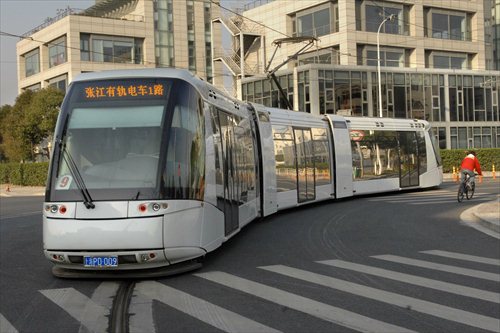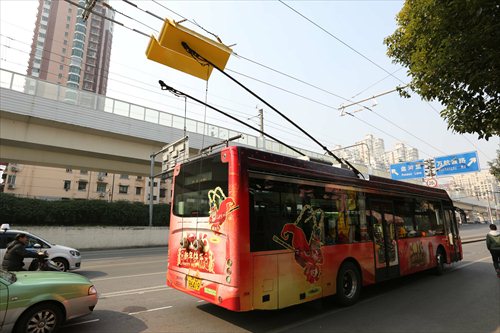HOME >> METRO SHANGHAI
Shanghai’s classic trolley buses and trams are on a resurgence
Source:Global Times Published: 2016-2-23 19:08:04

A tram operates in Zhangjiang Hi-Tech Park in Pudong New Area. Photo: IC
Shanghai's iconic trolley buses have long been joked about by locals who often refer to them as the "braids" of the city. But the electric-powered transport system looked until recently as though it was going to be faded out, like many other aspects of city life. The oldest trolley route, the No. 14, was shut down in June 2014.
The good news is that in 2017 there will be an addition to the trolley bus fleet - an 18-meter new-generation bus will be traveling daily down Yan'an Road running from Yan'an Road East to the Huqingping Highway, a route of about 18 kilometers with 27 stops.
To accommodate the new route, the existing bus lanes on Yan'an Road will be moved from the outer to the middle of the road and passenger stops will be built under the viaducts.
Yan'an Road is a key traffic corridor connecting east and west downtown Shanghai. It is one of the busiest roads in the city and carries some 5,000 public transport passengers alone every hour. There are no metro stations along the road and this makes the new trolley bus route important.
Modern services
Alongside the resurgence in trolley buses, Shanghai's first modern tram service began operating in Zhangjiang Hi-Tech Park, Pudong New Area in 2009.
Another tram system is currently being constructed in Songjiang district. This will comprise six routes covering 145 kilometers. These new "zero-emission" trams are much better designed, quieter and faster than traditional trams.
These new bright state-of-the-art rubber-tired trams have been described as being shaped like silkworms. These trams can carry 300 passengers at a time on the two routes at present operating. Eventually some 78 trolley buses are expected to serve this area.
The history of trams in Shanghai dates back to 1907 when the Shanghai Electric Construction Company was founded by British businessmen. On March 5, 1908, the first tram in China trundled along 6 kilometers from Jing'an Temple to the Bund. Later a second tram route was opened and more followed. By 1937 there were 10 tram lines running.
During the War of Resistance against Japanese Aggression (1937-45) some of the lines were destroyed but by 1949 there were 77 kilometres of tram tracks in the city and 107 trams operating.
As well as the British company, a French company built eight tram routes in the then French concession.
In November 1914, the first trolley bus in China ran from Dongxinqiao Bridge in today's Huangpu district to Zhengjiamu Bridge. This service was also launched by the Shanghai Electric Construction Company and ran 1.1 kilometers downtown.

A No.20 trolley bus runs on a Shanghai street. Photo: IC
More flexible
Compared to trams, the trolley buses were more flexible to run. Trolley buses can change direction and move around traffic. Developing a trolley bus route is also less expensive and time-consuming.
Over the next few years the company opened several more trolley bus routes. In January 1920, the second trolley bus, Route No.16, began operating from the intersection of today's Xizang Road Middle and Beijing Road East to Henan Road Bridge. From 1927 to 1938, the number of routes rose from five to nine, and the number of buses increased from 85 to 120. Trolley bus routes extended to cover some 54 kilometers.
In the French concession the French transport company also moved into the trolley bus business, opening its first route in 1926 and four more until 1938.
In July, 1951, Shanghai saw its first home-grown trolley bus built and in July 1953 buses on route 21 were running through the city. A second route, from Zhabei to Xujiahui districts opened in December 1959.
By 1967 trolley buses had replaced trams in the busiest parts of the city like Huaihai and Nanjing roads, and routes were expanded into the suburbs. In 1994, the city had more than 20 trolley bus routes and around 986 trolley buses - the largest network of its kind in Asia and the third largest in the world. By 1990 the trolley bus routes covered nearly 300 kilometers.
In the late 1990s, the authorities began closing down trolley bus routes and by 2015, there were only about 10 trolley bus routes operating in the city.
They had lost popularity because they were generally not as quick or flexible as diesel-powered buses. And the spider web of wires needed to supply their current made many intersections ugly.
Environmentally friendly
But their supporters argued that trolley buses were more environmentally friendly. It has been suggested that if Shanghai added an extra 1,000 trolley buses to its fleet the city would reduce its emissions of carbon monoxide by 2,245 tons and nitride oxide by 1,040 tons annually.
Around 2000, the push to reinstate trams and trolley buses in the city grew stronger and one official from the Shanghai Bashi Public Transportation Group stated that trolley buses will not disappear and more new-generation trolley buses will be operating in the future.
It's not just Shanghai. There are now more than 350 cities throughout the world where trolley buses are part of the public transport network including Moscow, San Francisco, Milan and Rome.
Global Times
Newspaper headline: What’s old is new again!
Posted in: Metro Shanghai, City Panorama